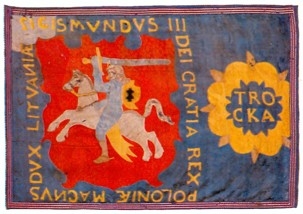

Last modified: 2014-04-11 by zoltán horváth
Keywords: lithuania |
Links: FOTW homepage |
search |
disclaimer and copyright |
write us |
mirrors
See also:
The photo of Trakai district (Traku pavietas) flag of early
17th century: the original flag is stored in the National
Museum of Lithuania.
On blue field with small silver canton at hoist on
red Renaissance shield simplified Vytis (National Arms), shield
surrounded with rectangle yellow motto "SIGISMUNDUS III DEI
GRATIA REX POLONIAE MAGNUS DUX LITVANIAE", at
fly yellow rose with golden sepals and blue centre with
yellow inscription "TROCKA", flag bordered with three
golden threads.
Blue field is traditional for flags of Trakai province (Traku
vaivadija), to which the Trakai district (Traku
pavietas) belonged. The National Arms shows the usage of
this flag as the military flag of nobles from Trakai
district conscripted to State military service, i.e.
mobilized to war. The inscription "Trocka" means the
Polish name "Trocka powiat" of Trakai district. The
motto mentions the name and main titles of the
then King Sigismund III, i.e. Sigismund Vasa.
Symptomatically, the Polish Royal numeration is used on flag,
despite of still used in official Lithuanian documents Grand
Ducal numeration, which calls Sigismund Vasa the Grand Duke
of Lithuania Sigismund IV (ruled in 1588-1632).
So this flag reflects both keeping the Lithuanian
self-consciousness and
the fading national traditions due to
the influence of Polish court.
Virginijus Misiunas, 3 January 2010
The lithography of Vilnius province governor's (Vilniaus
vaivada) flag of late 18th century: it was drawn in 19th century
by Hippolyte Maulin from the original flag (not survived till
now).
On yellow field praying Blessed Virgin Mary with red
robe and blue cloak, staying on blue sphere, stepped over
silver crescent and black snake holding red apple, crowned with
twelve golden 6-pointed stars, flanked with motto "MONSTRATE
ESSE MATREM" in golden letters. In upper right and lower
left corners black displayed eagle with three joined red horns on
blue breastshield, eagle decorated with green laurel branches and
ducal crown. In upper left and lower right corners red monogram
"KRX" decorated with green laurel branches and ducal
crown. At middle of upper edge composition of blue halberd, blue
oval shield and golden palm branch crossed with red banner and
golden laurel branch; at middle of lower edge the composition
repeated opposingly-directed. At middle of hoist edge composition
of red oval shield, red 'bulava' (governor's staff), blue and
golden saber with belt, blue halberd, golden branches of palm and
laurel; at middle of fly edge the composition repeated
opposingly-directed. Flag proportions approximately 7:10, finial
is double openwork lance head, staff is mahogany.
This typically baroque-overburden flag was used by prince Karolis
Stanislovas Radvila II (nickname "Panie Kochanku",
meaning "My Dear Sir") as the governor
(vaivada) of Vilnius province (Vilniaus vaivadija) in
1762-1764 and in 1768-1790.
To understand the background of flag correctly, we shall
know that was one of first positions of Grand Duchy of Lithuania.
As all the top positions in Lithuanian government, it
was a desired prize for most powerful noble families.
So every winner family demonstrated its glory as much as it
could, using state symbols together with house heraldry. The
yellow field is one of colours of princely Radvila house, unlike
traditional red of Vilnius province.
Blessed Virgin Mary is the Holy Patroness of Lithuania (Lithuania
has the title "Virgin Mary's land"), and she was
shown on the opposite side of State Flag (most likely, that
allowed avoiding Knight's sinister or fly direction).
The governor Karolis Stanislovas Radvila II has chosen her as the
main charge for his officiary flag, most likely because the main
symbol of Vilnius province was the National Arms, but its
repose usage was the prerogative of Grand Duke. Black eagle with
horns is the arms of princely Radvila house. In monogram there
letters K and R mean Karolis Radvila (more exactly, the
Polish form of name, Karol Radziwill), and X means the Polish
title "ksiaze", meaning prince/duke.
The compositions symbolize the military glory of Radvila house
and its merits in protecting citizens' rights. The 'bulava'
staff means the office of province governor.
Virginijus Misiunas, 3 January 2010